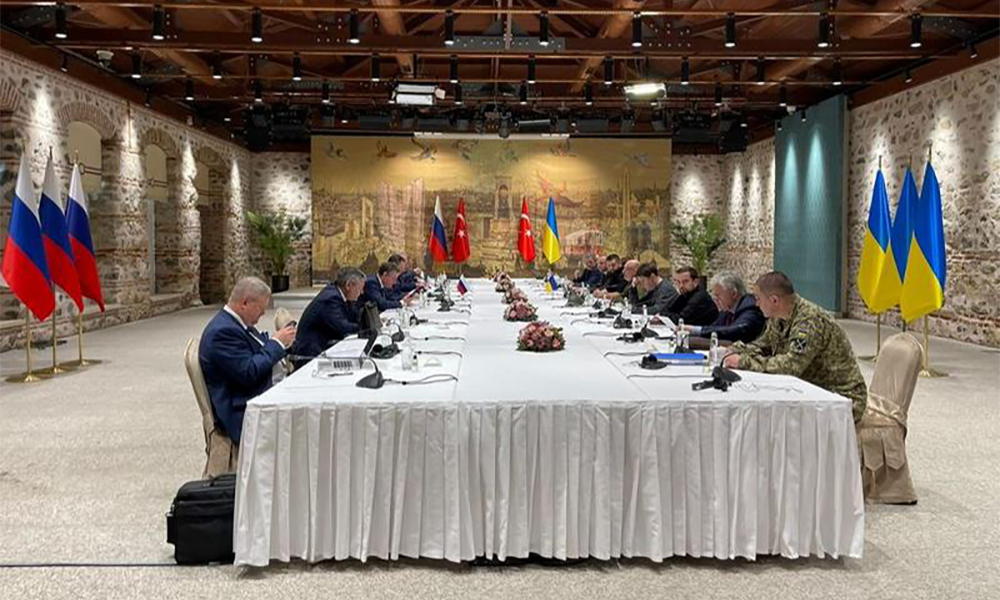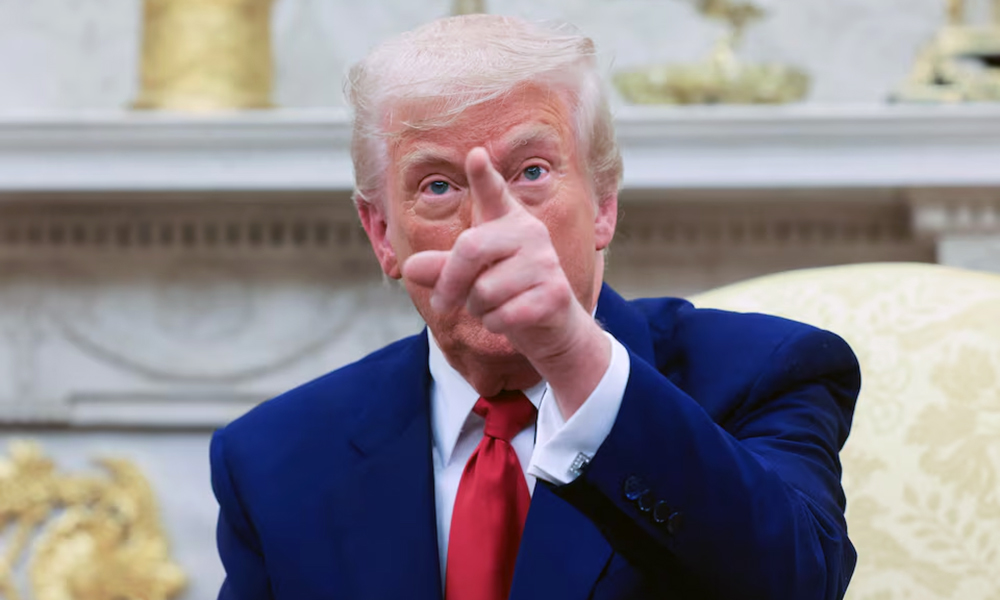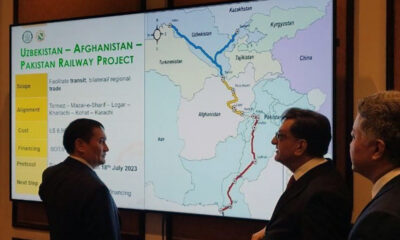World
Russia, Ukraine peace talks stall amid mutual recriminations

Peace negotiations between Russia and Ukraine have stagnated, officials said on Tuesday, with both sides trading blame and Moscow indicating a return to talks may be difficult.
Russia accused Ukraine of hardening its stance and the West for bolstering the government in Kyiv, with Foreign Minister Sergei Lavrov saying that Washington, London and Brussels want to use Ukraine to their strategic advantage.
Lavrov said he believes no pace deal can be made if negotiators try to “transfer the dialogue” to focus on what the West had to say instead of the immediate situation in Ukraine. That rules out chances for progress in talks, he added.
“We always say that we are ready for negotiations … but we were given no other choice,” Lavrov said.
Ukraine and Russia have held intermittent peace talks since the end of February 2022, just days after Russia invaded its neighbour, but there has been little communication between them in recent weeks.
Also on Tuesday, Lavrov’s deputy Andrey Rudenko said Ukraine “has practically withdrawn from the negotiation process,” while Russian negotiator Leonid Slutsky, said talks are not being conducted in any format.
“The (U.S.) State Department should not try to create “conditions” through military assistance to Kyiv. Useless,” Slutsky said.
The United States is expected to approve a $40 billion package of military and economic aid for Ukraine this week, with overall supply of weapons and aid from the West significantly increasing in recent weeks.
Ukrainian presidential adviser Mykhailo Podolyak confirmed that talks are “on hold” as Russia is not willing to accept that it “will not achieve any goals” and that the war is no longer going according to the Kremlin’s rules.
“Russia does not demonstrate a key understanding of today’s processes in the world,” Podolyak said, according to Ukrainian media. “And its extremely negative role.”
President Vladimir Putin says Russian forces are on a special operation to demilitarise and “denazify” Ukraine. The West and Kyiv call that a false pretext to invade.
Thousands have been killed and millions displaced by the war. It has also left Russia in the grip of tough Western sanctions, and has raised fears of a wider confrontation between Russia and NATO.
“We have had not 10 years, but 20 years since the West began to prepare tools, including the use of NATO and Ukraine to contain Russia since the late 90s. All these years we insisted on negotiations – we have been ignored,” Lavrov said.
“Now we will solve problems depending on how we see them. I will always emphasize: we are ready to solve humanitarian issues,” Lavrov said.
World
Trump says US and Iran set for direct nuclear talks; Tehran says they will be indirect
Iran’s Foreign Minister Abbas Araqchi posted on X that indirect high-level talks would be held in Oman, adding: “It is as much an opportunity as it is a test. The ball is in America’s court.”

President Donald Trump made a surprise announcement on Monday that the United States and Iran were poised to begin direct talks on Tehran’s nuclear program, but Iran’s foreign minister said the discussions in Oman would be indirect, Reuters reported.
In a further sign of the difficult path to any deal between the two geopolitical foes, Trump issued a stark warning that if the talks are unsuccessful, “Iran is going to be in great danger.”
Iran had pushed back against Trump’s demands in recent weeks that it directly negotiate over its nuclear program or be bombed, and it appeared to be sticking to that position on Monday.
“We’re having direct talks with Iran, and they’ve started. It’ll go on Saturday. We have a very big meeting, and we’ll see what can happen,” Trump told reporters in the Oval Office during a meeting with visiting Israeli Prime Minister Benjamin Netanyahu.
“And I think everybody agrees that doing a deal would be preferable,” Trump said. He added that Saturday’s talks with Iran would be at a very high level, without elaborating. He declined to say where the talks would take place but held out the possibility that a deal could be reached.
Iran’s Foreign Minister Abbas Araqchi posted on X that indirect high-level talks would be held in Oman, adding: “It is as much an opportunity as it is a test. The ball is in America’s court.”
The U.S. and Iran held indirect talks during former President Joe Biden’s term but they made little if any progress. The last known direct negotiations between the two governments were under then-President Barack Obama, who spearheaded the 2015 international nuclear deal that Trump later abandoned.
Warnings by Trump of military action against Iran had jangled already tense nerves across the Middle East after open warfare in Gaza and Lebanon, military strikes on Yemen, a change of leadership in Syria and Israeli-Iranian exchanges of fire.
Trump, who has beefed up the U.S. military presence in the region since taking office in January, has said he would prefer a deal over Iran’s nuclear program to armed confrontation and on March 7 said he had written to Supreme Leader Ayatollah Ali Khamenei to suggest talks, read the report.
Iranian officials said at the time that Tehran would not be bullied into negotiations.
“Iran cannot have a nuclear weapon and if the talks aren’t successful I actually think it will be a very bad day for Iran,” Trump said in the Oval Office on Monday.
Direct talks would not occur without the explicit approval of Khamenei, who in February said negotiations with the U.S. were “not smart, wise, or honorable.”
Hours before Trump’s announcement, Iranian Foreign Ministry spokesperson Esmail Baghaei said Iran was awaiting a U.S. response to Tehran’s proposal for indirect negotiations. He said the Islamic Republic believed it was making a generous, responsible and honorable offer.
After Trump spoke, a senior Iranian official, speaking on condition of anonymity, told Reuters: “The talks will not be direct … It will be with Oman’s mediation.” Oman, which maintains good relations with both the U.S. and Iran, has been a longtime channel for messages between the rival states.
Iran’s Nournews, affiliated with the country’s top security body, described Trump’s statement about a planned direct meeting as part of a “psychological operation aimed at influencing domestic and international public opinion.”
A second Iranian official, speaking on condition of anonymity, said over the weekend there was possibly a window of around two months to reach a deal, citing worries that Iran’s longtime foe Israel might launch its own attack if talks took longer.
Netanyahu, who has shown little support for U.S. negotiations with Iran, said if diplomacy could prevent Tehran from ever getting nuclear weapons “in a full way, the way it was done in Libya, I think that would be a good thing.”
During his 2017-2021 term, Trump withdrew the U.S. from the 2015 deal between Iran and world powers designed to curb Iran’s sensitive nuclear work in exchange for sanctions relief. Trump also reimposed sweeping U.S. sanctions, Reuters reported.
Since then, Iran has far surpassed that deal’s limits on uranium enrichment.
Western powers accuse Iran of having a clandestine agenda to develop nuclear weapons capability by enriching uranium to a high level of fissile purity, above what they say is justifiable for a civilian atomic energy program.
Tehran says its nuclear program is wholly for civilian energy purposes.
The White House National Security Council did not immediately respond to a request for details.
The shift comes at a precarious time for Tehran’s regional “Axis of Resistance” which it has established at great cost over decades to oppose Israel and U.S. influence. The axis has been severely weakened since the Palestinian group Hamas’ attack on Israel on October 7, 2023, tipped the Middle East into conflict.
Hamas in Gaza and Hezbollah in Lebanon have been hammered by Israel since the Gaza war began while the Houthi movement in Yemen has been targeted by U.S. airstrikes since last month. Israel severely damaged Iran’s air defenses last year.
The fall of Syrian President Bashar al-Assad, another key Iranian ally, has further weakened the Islamic Republic’s influence.
World
Anti-Trump protesters gather in Washington, other US cities
Some 150 activist groups had signed up to participate, according to the event’s website. Protests were planned in all 50 states plus Canada and Mexico.

Thousands of protesters gathered in Washington, D.C., and across the U.S. on Saturday, part of some 1,200 demonstrations that were expected to form the largest single day of protest against President Donald Trump and his billionaire ally Elon Musk since they launched a rapid-fire effort to overhaul government and expand presidential authority.
People streamed onto the expanse of grass surrounding the Washington Monument under gloomy skies and light rain. Organizers told Reuters that more than 20,000 people were expected to attend a rally at the National Mall.
Some 150 activist groups had signed up to participate, according to the event’s website. Protests were planned in all 50 states plus Canada and Mexico.
Terry Klein, a retired biomedical scientist from Princeton, New Jersey, was among those who gathered by the stage beneath the Washington Monument.
She said she drove down to attend the rally to protest Trump’s policies on “everything from immigration to the DOGE stuff to the tariffs this week, to education. I mean, our whole country is under attack, all of our institutions, all the things that make America what it is.”
The crowd around the memorial continued to build throughout the day. Some carried Ukrainian flags and others wore Palestinian keffiyeh scarves and carried “Free Palestine” signs, while Democrats from the U.S. House of Representatives blasted Trump’s policies on stage.
Wayne Hoffman, 73, a retired money manager from West Cape May, New Jersey, said he was concerned about Trump’s economic policies, including his widespread use of tariffs.
“It’s going to cost the farmers in the red states. It’s going to cost people their jobs – certainly their 401Ks. People have lost tens of thousands of dollars,” Hoffman said.
Kyle, a 20-year-old intern from Ohio, was a lone Trump supporter, sporting a “Make America Great Again” hat and walking the fringe of the Washington, D.C., rally while engaging protesters in debate.
“Most people aren’t too hostile. A few people cuss,” said Kyle, who declined to give his last name.
Trump, who shook financial markets and upset nations around the world with a raft of trade tariffs this week, spent the day in Florida, playing a round of golf at his club in Jupiter before returning to his Mar-a-Lago compound in the afternoon.
Some four miles (6 km) from Mar-a-Lago in West Palm Beach, more than 400 demonstrators gathered on a sunny day in protest. Drivers honked their horns in support of the pastel-and khaki-clad demonstrators as they passed by.
“Markets tank, Trump golfs,” read one sign.
At another protest in Stamford, Connecticut, Sue-ann Friedman, 84, brought a bright pink, handmade sign objecting to the administration’s moves to cut funding for medical research.
“I thought my marching days were over, and then we get somebody like Musk and Trump,” said Friedman.
Paul Kretschmann, a 74-year-old retired attorney in Stamford, said it was the first time he had ever attended a protest.
“My concern is that Social Security is going to be gutted, that we’re going to lose our benefits, and that there’s going to be nobody around to administer it in the first place,” he said. “I’m afraid that this is all part of a larger plan to dismantle the government and for Trump to maintain power.”
With Trump’s blessing, Musk’s Department of Government Efficiency team has scythed through the U.S. government, eliminating more than 200,000 jobs from the 2.3 million federal workforce. At times, the effort has been haphazard and forced the recall of needed specialists.
On Friday, the Internal Revenue Service began laying off more than 20,000 workers, as much as 25% of its ranks.
Several hundred people gathered outside the headquarters of the Social Security Administration, a top DOGE target, near Baltimore to protest against cuts to the agency which delivers benefits to the elderly and disabled.
Linda Falcao, who turns 65 in two months, told the crowd she had been paying into the Social Security fund since the age of 16.
“I’m terrified, I’m angry, I’m pissed, I’m bewildered this could happen to the United States,” she said. “I do love America and I’m heartbroken. I need my money. I want my money. I want my benefits!” The crowd chanted, “It’s our money!”
White House assistant press secretary Liz Huston disputed the protesters’ charge that Trump aimed to cut Social Security and Medicaid.
“President Trump’s position is clear: he will always protect Social Security, Medicare, and Medicaid for eligible beneficiaries. Meanwhile, the Democrats’ stance is giving Social Security, Medicaid, and Medicare benefits to illegal aliens, which will bankrupt these programs and crush American seniors,” Huston said in an email.
Much of Trump’s agenda has been restrained by lawsuits contending he has overstepped his authority with attempts to fire civil servants, deport immigrants and reverse transgender rights.
Trump returned to office on January 20 with a stream of executive orders and other measures critics say are aligned with an agenda outlined by Project 2025, a deeply conservative political initiative to reshape government and consolidate presidential authority. His supporters have applauded Trump’s audacity as necessary to disrupt entrenched liberal interests.
Hours before the protests were due to kick off in the United States, hundreds of anti-Trump Americans living in Europe gathered in Berlin, Frankfurt, Paris and London to voice opposition to Trump’s sweeping makeover of U.S. foreign and domestic policies.
World
As Iran tensions build, US military moves warplanes to reinforce Middle East
U.S. President Donald Trump threatened Iran on Sunday with bombing and secondary tariffs if Tehran did not come to an agreement with Washington over its nuclear program.

U.S. Defense Secretary Pete Hegseth has reinforced U.S. military capability in the Middle East with more warplanes, the Pentagon said on Tuesday, amid a more than two-week-old U.S. bombing campaign in Yemen and mounting tensions with Iran, Reuters reported.
The Pentagon’s brief statement did not specify which aircraft were being deployed or where precisely they were sent.
However, as many as six B-2 bombers have relocated in the past week or so to a U.S.-British military base on the Indian Ocean island of Diego Garcia, according to U.S. officials, speaking on condition of anonymity.
Experts say that puts the B-2s, which have stealth technology and are equipped to carry the heaviest U.S. bombs and nuclear weapons, in an ideal position to operate in the Middle East.
“Should Iran or its proxies threaten American personnel and interests in the region, the United States will take decisive action to defend our people,” Pentagon spokesperson Sean Parnell said in a statement.
The U.S. military’s Strategic Command has declined to say how many B-2s have reached Diego Garcia and noted that it does not comment on exercises or operations involving the B-2.
There is already considerable firepower in the Middle East and the U.S. military will soon have two aircraft carriers in the region, read the report.
U.S. President Donald Trump threatened Iran on Sunday with bombing and secondary tariffs if Tehran did not come to an agreement with Washington over its nuclear program.
While B-2 bombers have been employed to strike buried Houthi targets in Yemen, most experts say use of the stealthy bomber is overkill there and the targets aren’t buried so deeply.
However, the B-2 is equipped to carry America’s most potent bomb — the 30,000-pound GBU-57 Massive Ordnance Penetrator. That is the weapon that experts say could be used to strike Iran’s nuclear program.
There are only 20 B-2 bombers in the Air Force’s inventory so they are usually used sparingly.
Iran’s Supreme Leader Ayatollah Ali Khamenei said on Monday the U.S. would receive a strong blow if Trump followed through with his threats.
Revolutionary Guards Aerospace Commander Amirali Hajizadeh threatened U.S. forces in the Middle East, noting American bases in the Middle East and adding: “They are in a glass house and should not throw stones.”
One official told Reuters that the U.S. military was also moving some air defense capabilities from Asia to the Middle East.
In his 2017-2021 term, Trump withdrew the U.S. from a 2015 deal between Iran and world powers that placed strict limits on Tehran’s disputed nuclear activities in exchange for sanctions relief. Trump also reimposed sweeping U.S. sanctions.
Since then, Iran has far surpassed that deal’s limits on uranium enrichment.
Western powers accuse Iran of having a clandestine agenda to develop nuclear weapons capability by enriching uranium to a high level of fissile purity, above what they say is justifiable for a civilian atomic energy program. Tehran says its nuclear program is wholly for civilian energy purposes.
-

 Latest News5 days ago
Latest News5 days agoKhyber Pakhtunkhwa chief minister proposes permanent residence for Afghan refugees
-

 Business4 days ago
Business4 days agoTrump unveils first $5 million ‘gold card’ visa
-

 Latest News5 days ago
Latest News5 days agoSixty Afghans rounded up in Rawalpindi and Islamabad
-

 Regional5 days ago
Regional5 days agoIsrael steps up Syria strikes, says Turkey aims for ‘protectorate’
-

 Latest News4 days ago
Latest News4 days agoEU-Central Asia summit calls for inclusive government in Afghanistan
-

 Latest News5 days ago
Latest News5 days agoThirty, killed, 155 injured in traffic accidents in Afghanistan during Eid
-

 Latest News4 days ago
Latest News4 days agoUS has no plans for reopening of its embassy in Kabul
-

 Sport5 days ago
Sport5 days agoIyer blitz powers Kolkata to big IPL win over Hyderabad
























